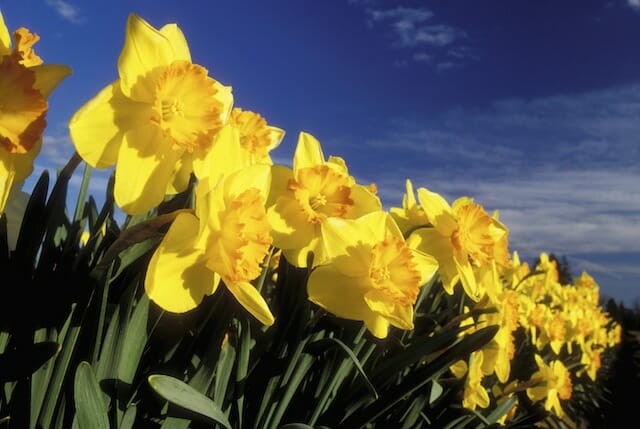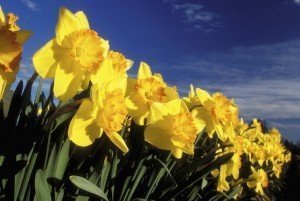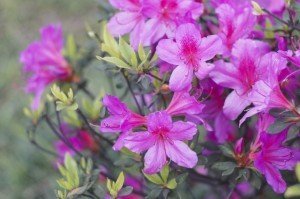
Spring-Flowering Bulb Questions
SPRING-FLOWERING BULB QUESTIONS
Dr. Leonard Perry, Horticulture Professor
University of Vermont
Fall is the time to fast-forward and plan for spring, at least in terms of planting spring-flowering bulbs such as daffodils and tulips. They’re easy, and will be a welcome sight next spring coming off of our typically long winter. Here are ten common questions you may have on what to plant, and how to go about it.
Q. Are there any bulbs that are deer resistant? Although deer may eat anything if they are really hungry from lack of other food, or there are too many deer for a given area, they almost always leave daffodils alone. That’s the main reason I began planting so many years ago. They contain calcium oxalate crystals, which cause a burning sensation when ingested.
Daffodils also contain a toxic alkaloid “lycorine”. A bite of the plant causes stomach upset, but quantities can be toxic to not only deer but also to cats, dogs, horses, and humans. Other bulbs that may be deer resistant include crocus, ornamental onions (Allium), squill, glory-of-the-snow (Chionodoxa), grape hyacinths, and snow drops. Interplanting tulips and daffodils may be effective in training deer not to browse.
Q. What bulbs are most hardy? Most spring-flowering bulbs are hardy throughout our north country, except for some of the species tulips. English bluebells are less hardy than their Spanish relatives.
Q. I’ve had tulips in t he past, but they haven’t lived and bloomed more than one year. What did I do wrong? You did nothing wrong, as this is the nature of most tulips—treat them as gorgeous annuals for their spring beauty. There are some tulips—hardy species ones and Darwin hybrids in particular—that are perennial and will return and bloom for several years. Look for such in the bulb descriptions.
he past, but they haven’t lived and bloomed more than one year. What did I do wrong? You did nothing wrong, as this is the nature of most tulips—treat them as gorgeous annuals for their spring beauty. There are some tulips—hardy species ones and Darwin hybrids in particular—that are perennial and will return and bloom for several years. Look for such in the bulb descriptions.
Most tulips need specific conditions to rebloom, as they have in their native Turkey and central Asia—hot and dry summers. Even then, the tulips you buy have been grown for several years in Holland to their peak of maturity, and they split into many baby bulbs right after bloom.
Q. I have shade and wet soils. Are there any bulbs that I can grow? Bulbs really need soils that don’t stay wet. Checquered lily (Fritillaria meleagris) is an exception that tolerates soils that are wet or periodically flooded. Otherwise, consider a different site or berm.
Bulbs grow and bloom best in full sun, but there are some that tolerate part (four to six hours of direct sun) to full shade. Those that bloom early in spring, such as snowdrops, squill, and glory-of-the-snow, can make sufficient nutrients and will die back as leaves come out on deciduous trees (such as maples and oaks). Other good choices for part shade sites include the checkquered lily and bluebells or wood hyacinths. The low, yellow woodland tulip (Tulipa sylvestris) also grows well in sun or shade.
Q. Each year squirrels, rodents, and small mammals such as skunks dig up my bulbs. How can I prevent this? First, try some granular animal repellents you can buy and sprinkle around your plantings. Try liberally sprinkling ground shells or rocks (you can buy such in the poultry area of feed stores, or even in garden stores for bulb planting) in planting holes or beds, along with the bulbs. When critters dig and reach these sharp bits, this often discourages them. Finally, if using a permanent bed for planting each year, such as with their favorite tulips, line it first with wire mesh such as hardware cloth or poultry mesh, then cover it with the same (just remember to remove hardware cloth when bulbs sprout in spring).
Q. How close and deep do I plant bulbs? Generally, plant about two to three times the bulb diameter in depth. So the top of a tulip, hyacinth, or daffodil bulb, a couple inches wide, should be planted about five to size inches deep. Plant smaller bulbs such as crocus, snowdrops, or grape hyacinths with their tops about two to three inches deep.
Spacing depends partly on your budget, partly on the effect desired. If you want a more showy effect sooner, plant bulbs closer. On average, space tulips about four to six inches apart, daffodils six to eight inches apart, and small bulbs (like crocus) three to four inches apart. Tulips are formal, so best planted in even numbers, in formal rows, and in masses (rather than a straight line). Daffodils are informal in effect, so best randomly arranged and spaced throughout a bed or landscape.
Q. Do I need to add fertilizer when planting bulbs and, if so, why kind and how much? Bulbs already contain nutrients for the coming year, so if you’re just planting tulips for a one-time show, fertilizer really doesn’t help. But, if you’re planting perennial tulips, daffodils, or other perennial bulbs, add a source of phosphorus (such as superphosphate or natural rock phosphate). Phosphorus is needed for root growth, and doesn’t move much in the soil so needs adding at planting. Best is to use a bulb fertilizer formulated just for them. Best is not to use bone meal, as it attracts skunks and other mammals.
Don’t use too much fertilizer, as it can burn the base of the bulb. If planting bulbs such as daffodils individually in holes, only use a quarter teaspoon or so of fertilizer. If a larger bed, use about one-quarter cup per 10 square feet. Make sure to work the fertilizer in, and place a layer of soil between it and the bulb base.
In subsequent years, fertilize in late summer or early fall when bulbs are making roots. You can sprinkle bulb fertilizer on the surface then, according to label directions, or water bulbs with a liquid fertilizer high in phosphorus (the middle number on the fertilizer analysis).
Q. Bulb leaves look unsightly in spring after bloom. Can I cut them off? Not if you want bulbs the following year, as that is when they’re making nutrients for that next spring. You can “trombone” them if just a few, bending the leaves double and holding with a rubber band. Or, as they die back , you can cut them back by half. If you’re worried about their looks, interplant among other perennials that will hide the dying bulb foliage as the perennials grow.
, you can cut them back by half. If you’re worried about their looks, interplant among other perennials that will hide the dying bulb foliage as the perennials grow.
Q. I’m behind in my gardening. How late can I plant bulbs? Spring-flowering bulbs need about six weeks to root in the fall, so they don’t frost heave in the spring, and have roots when the tops begin growing then. Bulb roots tend to grow until about early November in colder climates. So, this means mid September to early October is the best time to plant there. Plant too soon, when the ground is still warm, and bulb tops may start to grow. Even if you’re late planting them in the fall, this is better than trying to hold bulbs until spring—they’ll start growing then before you can get them planted, and they need winter cold to form flowers.
Q. How do I go about “forcing” spring bulbs in pots for spring bloom? Bulbs need 10 to 12 weeks of cold (40 degrees F or lower, but not freezing too severely), to form blooms next spring. If you don’t have such in a cellar, coldframe, or old refrigerator, you can pot the bulbs (plant three daffodils or four tulips in a pot 6-inches wide), then bury them in the ground, pots and all. Pot rims can be at the soil surface or slightly below. Then add a few inches of bark or straw mulch. Use soil or compost for mulch instead if you have rodents. The advantage to using a cold space indoors is that pots are much more accessible earlier in the spring than if they’re buried and frozen in the ground.
Distribution of this release is made possible by University of Vermont and New England Grows–a conference providing education for industry professionals and support for university outreach efforts in horticulture.
Receive your complimentary Relocation guide and magazine


